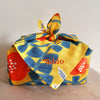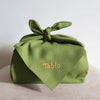Why food waste can be reused for fashion?
The overall benefits of reusing textiles allow them to be repurposed into new clothing items without them ending up in landfill and more resources required to make clothing. This is unparalleled when it comes to food waste.
Roughly 1/3 of all food produced, ends up in bins worldwide or wasted. That amounts to 1.3 billion tons of food suitable for human consumption and 1.6 billion tons of "primary product equivalents” are lost or wasted. Many fruits and Vegetables are not bought in stores because they don't appeal to a certain appearance. The food itself is perfectly edible but some bruising here and there means that consumers don't want to buy ugly fruits and vegetables.
Well instead of these foods going straight to waste, why not repurpose them into natural dyes?
Tabio continue to drive innovation and sustainability initiatives from Japan to the global market. By using natural food dyes, the socks maintain an organic touch and steer away from other companies that use cheap and harsh chemical dyes in their products that are harmful for the skin in the long run.
Tabio x Food Textile Materials
Matcha
The beautiful green of Japanese matcha calms the heart and soothes the soul. After Matcha is ground with stone mills and sifted, irregularly shaped and remaining pieces are used for dyeing.
Ginger
Ginger is a flowering plant, widely used as a spice.
It helps improve blood circulation and reduce water retention in your body. Unused parts are used to dye the sock.
Red Turnip
The Red Turnip is a famous vegetable native to the Kiso town in Japan. The colour extracted from this vegetable is an unexpected beautiful blue colour. The excess red turnips left behind when making sunki pickles from red turnip leaves are used for dyeing.
Rose
Rich scented rose petals are commonly used for beauty products.
We use the Rose petals that didn't make it to production to dye these socks.
Senburi (Swertia Japonica)
Senburi (Sertia Japonica) is a biennial herb that is native all over Japan. It has been used as a folk medicine to treat indigestion, nausea and anorexia. Senburi after extraction is used for dyeing.
Blueberry
Blueberry cultivation is carefully curated from the initial soil preparation to the final stage of harvest. Blueberries that are damaged during harvest or are irregularly shaped are used for dyeing.




























Leave a comment